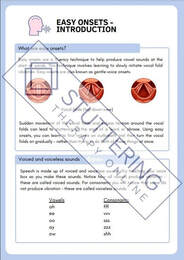Easy onsets (also known as gentle voice onsets)
Easy onsets are a fluency technique to help produce vowel sounds at the start of words. Easy onset speech refers to the slow initiation of vocal fold vibration (Max & Caruso, 1997).
Speech is made up of voiced and voiceless sounds. Try touching your voice box as you make some vowel sounds and notice that you can feel vibration from the vocal folds.
Sudden movement of the vocal folds and excess tension around the vocal folds can lead to stuttering at the start of a word or phrase. Using easy onsets, you can learn to first initiate an outbreath and then turn the vocal folds on gradually – rather than trying to do both of these things at once.
“h” is a voiceless sound and adding this to the start of the word means that the vocal folds do not go straight from a closed position to suddenly vibrating when the vowel is produced. So, the word “after” would be produced more like “hhhhhafter” when using an easy onset.
Easy onsets are similar to another technique called soft contacts, although soft contacts are used to help produce consonant sounds.
Speech is made up of voiced and voiceless sounds. Try touching your voice box as you make some vowel sounds and notice that you can feel vibration from the vocal folds.
Sudden movement of the vocal folds and excess tension around the vocal folds can lead to stuttering at the start of a word or phrase. Using easy onsets, you can learn to first initiate an outbreath and then turn the vocal folds on gradually – rather than trying to do both of these things at once.
“h” is a voiceless sound and adding this to the start of the word means that the vocal folds do not go straight from a closed position to suddenly vibrating when the vowel is produced. So, the word “after” would be produced more like “hhhhhafter” when using an easy onset.
Easy onsets are similar to another technique called soft contacts, although soft contacts are used to help produce consonant sounds.
Learning easy onsets
You can start to learn easy onsets by working through the exercises below:
Learning easy onsets with vowel sounds
- Start by breathing out with a quiet sigh. This will produce a quiet “hhhhh” sound. It should not be a harsh sound and the voice should not yet be turned on.
- Slowly turn on the voice to produce a vowel sound - “hhhhheee”. The voice should turn on very gradually. The “h” sound before the vowel should be stretched out at this stage.
- Try producing a range of vowels with easy onsets - e.g. ay, ah, ee, ow, oo.

Learning easy onsets with single words
Apply the technique above to some single words that start with vowels.
For example:
Apply the technique above to some single words that start with vowels.
For example:
Anna (which would become “hhhhhanna”)
After
Also
Always
Enough
Easy
Email
Either
Exit
Expert
Inside
Inspect
Include
Island
Oven
Open
Offer
Outdoor
Under
Uncle
Update
Unless
After
Also
Always
Enough
Easy
Either
Exit
Expert
Inside
Inspect
Include
Island
Oven
Open
Offer
Outdoor
Under
Uncle
Update
Unless
Tired of Stuttering?
We can help. Learn more about our proven therapy and how we guarantee you will be happier with how you speak - or your money back.
|
Are you a therapist?
|
Learning easy onsets with phrases
Practice using the same technique with some the phrases below.
Practice using the same technique with some the phrases below.
Excuse me… (which would become “hhhhheeexcuse me”)
Of course.
After you.
It’s been a brilliant day.
Is it raining?
Enough is enough!
I’ll see you later.
Are you hungry?
Is this a good time?
Open the door, please.
Uncle Patrick is here.
Are you busy?
I’ll have a pizza, please.
Of course.
After you.
It’s been a brilliant day.
Is it raining?
Enough is enough!
I’ll see you later.
Are you hungry?
Is this a good time?
Open the door, please.
Uncle Patrick is here.
Are you busy?
I’ll have a pizza, please.
Think of your own phrases that start with a vowel – particularly those that you use often and that you think you might stutter on.
Record yourself saying these phrases using easy onsets and listen back to check that you are using the technique.
Record yourself saying these phrases using easy onsets and listen back to check that you are using the technique.

Reducing the length on the easy onset
Experiment with the volume and length of the “h” sound before the vowel. With practice you will find that it can be made both quiet and less prolonged – so, the exaggerated easy onset that you were using at first becomes less noticeable.
Continue recording yourself trying this technique to find the right level of easy onset for you.
Experiment with the volume and length of the “h” sound before the vowel. With practice you will find that it can be made both quiet and less prolonged – so, the exaggerated easy onset that you were using at first becomes less noticeable.
Continue recording yourself trying this technique to find the right level of easy onset for you.
References
Max, L. & Caruso, A. J. (1997). Contemporary techniques for establishing fluency in the treatment of adults who stutter. Contemporary Issues in Communication Science and Disorders, 24, 45-52
Max, L. & Caruso, A. J. (1997). Contemporary techniques for establishing fluency in the treatment of adults who stutter. Contemporary Issues in Communication Science and Disorders, 24, 45-52
More Free Guides
Learn To Use Fluency Techniques In Real Life
Thinking About Stuttering Therapy? Here Are Our Top 5 Things To Know
|
Stuttering Therapy Online provides both free resources and one-to-one online therapy for stuttering. We care about helping you find the right support.
Paid Online Therapy
Modifying Phonation Intervals 2 Programme (MPI-2) |




